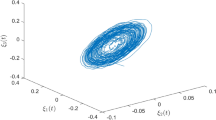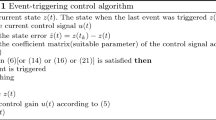Abstract
This paper studies the quasisynchronization problems of reaction-diffusion neural networks (RDNNs) with time-varying delays via event-triggered control. Firstly, a static event-triggered mechanism and a dynamic event-triggered mechanism are designed to significantly reduce computation costs and save communication resources, respectively. These two different event-triggered control strategies are also able to meet the requirements of various situations. Based on the static event-triggered mechanism, the dynamic event-triggered mechanism is designed to further reduce the sampling frequency by introducing an internal dynamic variable, and several quasisynchronization criteria are derived. However, the quasisynchronization error bounds are related to triggering parameters and can be flexible adjusted, which reduces the conservatism of the existing quasisynchronization results and extends the application of proposed control strategies. Meanwhile, there exists positive lower bounds for the inter event time which can exclude the Zeno behavior. Finally, numerical simulations are given to demonstrate the superiority of the obtained theoretical results, and one example is given to show the chaotic quasisynchronization of the proposed RDNNs in the application of secure communication.










Similar content being viewed by others
Data availibility statement
The data used during the current study are available from the corresponding author upon reasonable request.
References
Hopfield JJ, Tank DW (1986) Computing with neural circuits: a model. Science 233(4764):625–633
Marcus C, Westervelt R (1989) Stability of analog neural networks with delay. Phys Rev A 39(1):347
Zhang N, Wang X, Li W (2022) Stability for multi-linked stochastic delayed complex networks with stochastic hybrid impulses by Dupire Itô’s formula. Nonlinear Anal Hybrid Syst 45:101200
Lin H, Wang C, Tan Y (2020) Hidden extreme multistability with hyperchaos and transient chaos in a hopfield neural network affected by electromagnetic radiation. Nonlinear Dyn 99(3):2369–2386
Manivannan R, Cao Y, Chong KT (2022) Unified dissipativity state estimation for delayed generalized impulsive neural networks with leakage delay effects. Knowl Based Syst 254:109630
Lee TH, Park M-J, Park JH, Kwon O-M, Lee S-M (2014) Extended dissipative analysis for neural networks with time-varying delays. IEEE Trans Neural Netw Learn Syst 25(10):1936–1941
Cao J, Wang J (2005) Global exponential stability and periodicity of recurrent neural networks with time delays. IEEE Trans Circuits Syst I Regular Pap 52(5):920–931
Wang L, He H, Zeng Z (2020) Global synchronization of fuzzy memristive neural networks with discrete and distributed delays. IEEE Trans Fuzzy Syst 28(9):2022–2034
Ping J, Zhu S, Liu X (2022) Finite/fixed-time synchronization of memristive neural networks via event-triggered control. Knowl Based Syst, 110013
Tong D, Liu X, Chen Q, Zhou W, Liao K (2022) Observer-based adaptive finite-time prescribed performance NN control for nonstrict-feedback nonlinear systems. Neural Comput Appl 34(15):12789–12805
Zhang S, Yu Y, Wang H (2015) Mittag-leffler stability of fractional-order hopfield neural networks. Nonlinear Anal Hybrid Syst 16:104–121
Ozcan N (2019) Stability analysis of cohen-grossberg neural networks of neutral-type: multiple delays case. Neural Netw 113:20–27
Mani P, Rajan R, Shanmugam L, Joo YH (2019) Adaptive control for fractional order induced chaotic fuzzy cellular neural networks and its application to image encryption. Inf Sci 491:74–89
Cao Y, Cao Y, Guo Z, Huang T, Wen S (2020) Global exponential synchronization of delayed memristive neural networks with reaction-diffusion terms. Neural Netw 123:70–81
Xu Y, Sun F, Li W (2021) Exponential synchronization of fractional-order multilayer coupled neural networks with reaction-diffusion terms via intermittent control. Neural Comput Appl 33(23):16019–16032
Hu X, Wang L, Zhang C-K, Wan X, He Y (2023) Fixed-time stabilization of discontinuous spatiotemporal neural networks with time-varying coefficients via aperiodically switching control. Sci China Inf Sci 66(5):1–14
Tyagi S, Abbas S, Kirane M (2018) Global asymptotic and exponential synchronization of ring neural network with reaction-diffusion term and unbounded delay. Neural Comput Appl 30:487–501
Li X-Y, Fan Q-L, Liu X-Z, Wu K-N (2022) Boundary intermittent stabilization for delay reaction-diffusion cellular neural networks. Neural Comput Appl 34(21):18561–18577
Rakkiyappan R, Dharani S (2017) Sampled-data synchronization of randomly coupled reaction-diffusion neural networks with markovian jumping and mixed delays using multiple integral approach. Neural Comput Appl 28:449–462
Cao Y, Jiang W, Wang J (2021) Anti-synchronization of delayed memristive neural networks with leakage term and reaction-diffusion terms. Knowl Based Syst 233:107539
Wang J-L, Wu H-N, Huang T (2015) Passivity-based synchronization of a class of complex dynamical networks with time-varying delay. Automatica 56:105–112
Arenas A, Díaz-Guilera A, Kurths J, Moreno Y, Zhou C (2008) Synchronization in complex networks. Phys Rep 469(3):93–153
Assaneo MF, Ripollés P, Orpella J, Lin WM, Diego-Balaguer R, Poeppel D (2019) Spontaneous synchronization to speech reveals neural mechanisms facilitating language learning. Nat Neurosci 22(4):627–632
Kose MA, Prasad ES, Terrones ME (2003) How does globalization affect the synchronization of business cycles? Am Econ Rev 93(2):57–62
Tong D, Ma B, Chen Q, Wei Y, Shi P (2023) Finite-time synchronization and energy consumption prediction for multilayer fractional-order networks. IEEE Trans Circuits Syst II Exp Briefs 70(6):2176–2180
Zhang R, Zeng D, Park JH, Lam H-K, Xie X (2021) Fuzzy sampled-data control for synchronization of t-s fuzzy reaction-diffusion neural networks with additive time-varying delays. IEEE Trans Cybernet 51(5):2384–2397
Cao Z, Li C, He Z, Zhang X, You L (2022) Synchronization of coupled stochastic reaction-diffusion neural networks with multiple weights and delays via pinning impulsive control. IEEE Trans Netw Sci Eng 9(2):820–833
Wang J-L, Wu H-N, Huang T, Ren S-Y, Wu J (2016) Pinning control for synchronization of coupled reaction-diffusion neural networks with directed topologies. IEEE Trans Syst Man Cybernet Syst 46(8):1109–1120
Zhang H, Ding Z, Zeng Z (2020) Adaptive tracking synchronization for coupled reaction-diffusion neural networks with parameter mismatches. Neural Netw 124:146–157
Song X, Man J, Song S, Ahn CK (2021) Finite/fixed-time anti-synchronization of inconsistent markovian quaternion-valued memristive neural networks with reaction-diffusion terms. IEEE Trans Circuits Syst I Regular Pap 68(1):363–375
Shanmugam L, Mani P, Rajan R, Joo YH (2020) Adaptive synchronization of reaction-diffusion neural networks and its application to secure communication. IEEE Trans Cybernet 50(3):911–922
Chen W, Yu Y, Hai X, Ren G (2022) Adaptive quasi-synchronization control of heterogeneous fractional-order coupled neural networks with reaction-diffusion. Appl Math Comput 427:127145
Zhang R, Wang H, Park JH, Lam H-K, He P (2022) Quasisynchronization of reaction-diffusion neural networks under deception attacks. IEEE Trans Syst Man Cybernet Syst 52(12):7833–7844
Song X, Li X, Song S, Zhang Y, Ning Z (2021) Quasi-synchronization of coupled neural networks with reaction-diffusion terms driven by fractional brownian motion. J Franklin Inst 358(4):2482–2499
Lu B, Jiang H, Hu C, Abdurahman A (2020) Spacial sampled-data control for h\(\infty\) output synchronization of directed coupled reaction-diffusion neural networks with mixed delays. Neural Netw 123:429–440
Cao Y, Liu N, Zhang C, Zhang T, Luo Z-F (2022) Synchronization of multiple reaction-diffusion memristive neural networks with known or unknown parameters and switching topologies. Knowl Based Syst 254:109595
Zeng D, Zhang R, Park JH, Pu Z, Liu Y (2020) Pinning synchronization of directed coupled reaction-diffusion neural networks with sampled-data communications. IEEE Trans Neural Netw Learn Syst 31(6):2092–2103
Liu Y, Lin Y (2022) Synchronization of quaternion-valued coupled systems with time-varying coupling via event-triggered impulsive control. Math Methods Appl Sci 45(1):324–340
Wang X, Feng G (2023) Dynamic Event-Triggered \(\cal{H}_{\infty }\) Filtering for NCSs under multiple cyber-attacks. IEEE Trans Syst Man Cybernet Syst. https://doi.org/10.1109/TSMC.2023.3256970
Wang S, Cao Y, Guo Z, Yan Z, Wen S, Huang T (2021) Periodic event-triggered synchronization of multiple memristive neural networks with switching topologies and parameter mismatch. IEEE Trans Cybernet 51(1):427–437
Vadivel R, Ali MS, Joo YH (2020) Drive-response synchronization of uncertain markov jump generalized neural networks with interval time varying delays via decentralized event-triggered communication scheme. J Franklin Inst 357(11):6824–6857
Jin Y, Qi W, Zong G (2021) Finite-time synchronization of delayed semi-markov neural networks with dynamic event-triggered scheme. Int J Control Autom Syst 19(6):2297–2308
Cao Y, Wang S, Guo Z, Huang T, Wen S (2019) Synchronization of memristive neural networks with leakage delay and parameters mismatch via event-triggered control. Neural Netw 119:178–189
Wen S, Zeng Z, Chen MZ, Huang T (2017) Synchronization of switched neural networks with communication delays via the event-triggered control. IEEE Trans Neural Netw Learn Syst 28(10):2334–2343
Zhou Y, Zhang H, Zeng Z (2022) Quasisynchronization of memristive neural networks with communication delays via event-triggered impulsive control. IEEE Trans Cybernet 52(8):7682–7693
Cao Y, Wang S, Wen S (2019) Exponential synchronization of switched neural networks with mixed time-varying delays via static/dynamic event-triggering rules. IEEE Access 8:338–347
Kazemy A, Lam J, Zhang X-M (2022) Event-triggered output feedback synchronization of master-slave neural networks under deception attacks. IEEE Trans Neural Netw Learn Syst 33(3):952–961
Wang X, Park JH, Liu Z, Yang H (2023) Dynamic event-triggered control for GSES of memristive neural networks under multiple cyber-attacks. IEEE Trans Neural Netw Learn Syst. https://doi.org/10.1109/TNNLS.2022.3217461
Cai J, Feng J, Wang J, Zhao Y (2020) Quasi-synchronization of neural networks with diffusion effects via intermittent control of regional division. Neurocomputing 409:146–156
Chen W, Ren G, Yu Y, Yuan X (2023) Quasi-synchronization of heterogeneous stochastic coupled reaction-diffusion neural networks with mixed time-varying delays via boundary control. J Franklin Inst 360(13):10080–10099
Yang X, Cao J, Yang Z (2013) Synchronization of coupled reaction-diffusion neural networks with time-varying delays via pinning-impulsive controller. SIAM J Control Opt 51(5):3486–3510
Fan Y, Huang X, Li Y, Xia J, Chen G (2019) Aperiodically intermittent control for quasi-synchronization of delayed memristive neural networks: an interval matrix and matrix measure combined method. IEEE Trans Syst Man Cybernet Syst 49(11):2254–2265
Xin Y, Li Y, Huang X, Cheng Z (2019) Quasi-synchronization of delayed chaotic memristive neural networks. IEEE Trans Cybernet 49(2):712–718
Author information
Authors and Affiliations
Corresponding author
Ethics declarations
Conflict of interest
There is no conflict of interest in this paper.
Additional information
Publisher's Note
Springer Nature remains neutral with regard to jurisdictional claims in published maps and institutional affiliations.
Rights and permissions
Springer Nature or its licensor (e.g. a society or other partner) holds exclusive rights to this article under a publishing agreement with the author(s) or other rightsholder(s); author self-archiving of the accepted manuscript version of this article is solely governed by the terms of such publishing agreement and applicable law.
About this article
Cite this article
Cao, Y., Liu, N., Zhang, T. et al. Quasisynchronization of reaction-diffusion neural networks with time-varying delays by static/dynamic event-triggered control and its application to secure communication. Neural Comput & Applic (2024). https://doi.org/10.1007/s00521-024-09778-9
Received:
Accepted:
Published:
DOI: https://doi.org/10.1007/s00521-024-09778-9




